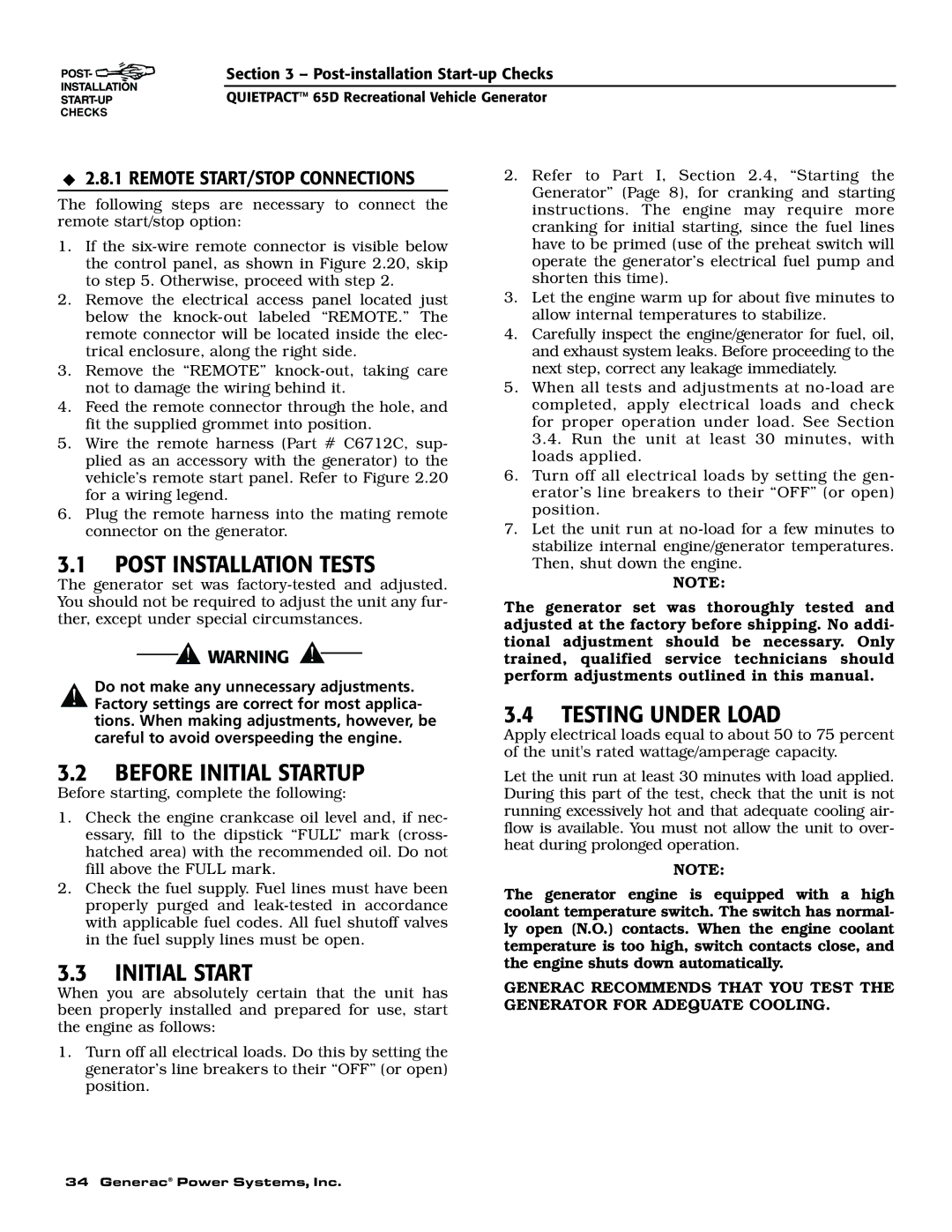
Section 3 –
QUIETPACT™ 65D Recreational Vehicle Generator
CHECKS
◆2.8.1 REMOTE START/STOP CONNECTIONS
The following steps are necessary to connect the remote start/stop option:
1.If the
2.Remove the electrical access panel located just below the
3.Remove the “REMOTE”
4.Feed the remote connector through the hole, and fit the supplied grommet into position.
5.Wire the remote harness (Part # C6712C, sup- plied as an accessory with the generator) to the vehicle’s remote start panel. Refer to Figure 2.20 for a wiring legend.
6.Plug the remote harness into the mating remote connector on the generator.
3.1POST INSTALLATION TESTS
The generator set was
Do not make any unnecessary adjustments. Factory settings are correct for most applica- tions. When making adjustments, however, be careful to avoid overspeeding the engine.
2.Refer to Part I, Section 2.4, “Starting the Generator” (Page 8), for cranking and starting instructions. The engine may require more cranking for initial starting, since the fuel lines have to be primed (use of the preheat switch will operate the generator’s electrical fuel pump and shorten this time).
3.Let the engine warm up for about five minutes to allow internal temperatures to stabilize.
4.Carefully inspect the engine/generator for fuel, oil, and exhaust system leaks. Before proceeding to the next step, correct any leakage immediately.
5.When all tests and adjustments at
6.Turn off all electrical loads by setting the gen- erator’s line breakers to their “OFF” (or open) position.
7.Let the unit run at
NOTE:
The generator set was thoroughly tested and adjusted at the factory before shipping. No addi- tional adjustment should be necessary. Only trained, qualified service technicians should perform adjustments outlined in this manual.
3.4TESTING UNDER LOAD
Apply electrical loads equal to about 50 to 75 percent of the unit's rated wattage/amperage capacity.
3.2BEFORE INITIAL STARTUP
Before starting, complete the following:
1.Check the engine crankcase oil level and, if nec- essary, fill to the dipstick “FULL” mark (cross- hatched area) with the recommended oil. Do not fill above the FULL mark.
2.Check the fuel supply. Fuel lines must have been properly purged and
3.3INITIAL START
When you are absolutely certain that the unit has been properly installed and prepared for use, start the engine as follows:
1.Turn off all electrical loads. Do this by setting the generator’s line breakers to their “OFF” (or open) position.
Let the unit run at least 30 minutes with load applied. During this part of the test, check that the unit is not running excessively hot and that adequate cooling air- flow is available. You must not allow the unit to over- heat during prolonged operation.
NOTE:
The generator engine is equipped with a high coolant temperature switch. The switch has normal- ly open (N.O.) contacts. When the engine coolant temperature is too high, switch contacts close, and the engine shuts down automatically.
GENERAC RECOMMENDS THAT YOU TEST THE GENERATOR FOR ADEQUATE COOLING.
34 Generac® Power Systems, Inc.
